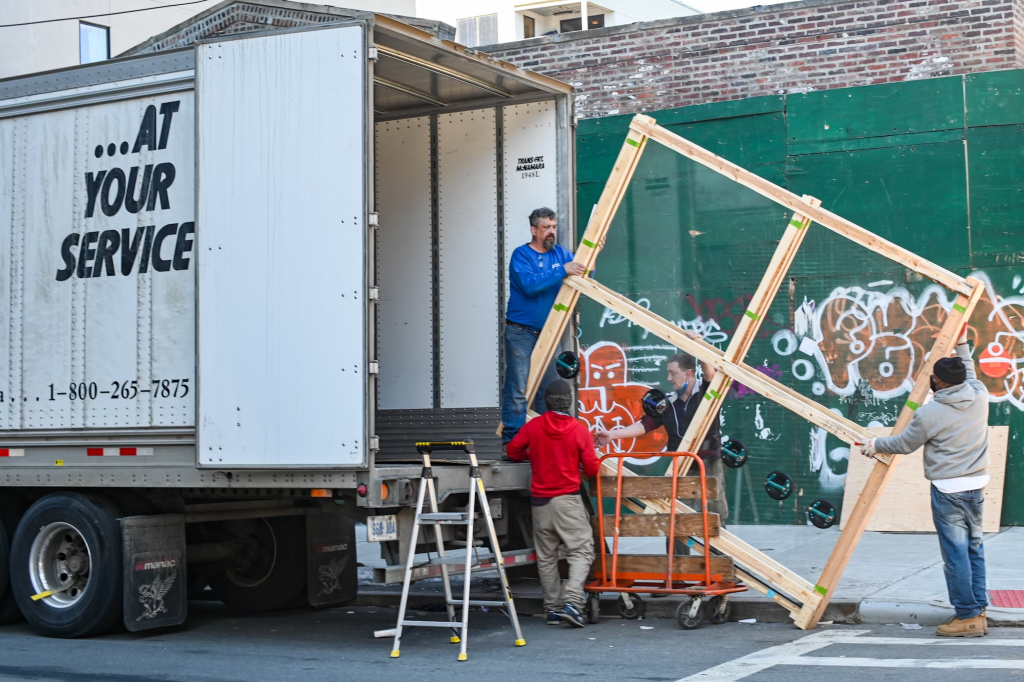Moving goods from one location to another can be a logistical challenge, but the job becomes even more demanding when faced with challenging road conditions.
Movers, whether transporting household items, office equipment, or specialised cargo, need to take various precautions and employ specific strategies to ensure that the move is completed safely and efficiently.

This article will examine the methods professional movers use to handle difficult road conditions and ensure the safety of their cargo, vehicles, and drivers.
Visit my link to support you through your challenging move.
How Do Movers Prepare For Challenging Road Conditions?
Now that we understand the types of challenging road conditions, let’s look at how professional movers prepare to tackle these situations. Preparation is key to overcoming obstacles and ensuring a smooth move.
Vehicle Maintenance And Suitability
To handle challenging road conditions, movers first ensure that their vehicles are in good working order. The type of vehicle used plays a crucial role in overcoming difficult roads.
- Inspection: Movers conduct thorough inspections of their trucks to ensure that all parts, including the brakes, tires, lights, and engine, are functioning correctly.
- Adapted Vehicles: Movers sometimes use specialised vehicles that are better equipped to handle adverse conditions. For example, all-terrain vehicles (ATVs) or trucks with reinforced suspension systems are ideal for mountain roads.
- Safety Features: Advanced safety features such as anti-lock brakes, traction control, and GPS systems are often installed to assist drivers during challenging conditions.
Weather Forecasting And Route Planning
Movers always stay up-to-date with the weather forecast. They monitor weather patterns and plan the route accordingly to avoid areas experiencing extreme conditions.
- Weather Monitoring: Movers use weather apps and local news reports to track conditions, such as rain or snowstorms, that may impact their journey.
- Route Adjustments: If weather conditions are predicted to worsen, the route may be adjusted to avoid areas affected by heavy snowfall or flooding.
Proper Loading And Securing Of Cargo
One of the most significant challenges when moving under harsh conditions is keeping the cargo safe. Whether it’s a household move or transporting delicate items, proper loading and securing of goods is essential.
- Cargo Restraint: Movers use various tools, such as ropes, straps, and padding, to ensure that items stay in place during the journey.
- Weight Distribution: Items are carefully arranged within the vehicle to ensure that the weight is evenly distributed. This helps maintain balance and stability, especially when navigating rough terrain.
Experienced Drivers
Experienced drivers play an essential role in navigating difficult road conditions. Movers often employ professional drivers with specific training in driving under challenging circumstances.
- Training: Drivers are trained to handle icy roads, steep inclines, and tight turns. They also know how to control the vehicle’s speed in challenging conditions.
- Patience and Caution: Movers are taught to drive with patience and caution in challenging conditions. They know that taking their time will ensure the move is completed safely.
Dealing With Specific Road Challenges
Different road conditions require different strategies. Let’s examine how movers handle specific road challenges in more detail.
How Movers Handle Snow And Ice
Movers must take extra care in snowy or icy conditions to avoid accidents or delays.
- Vehicle Preparation: Trucks are equipped with snow chains to improve traction, and winter tyres reduce the risk of sliding.
- Slow and Steady: Drivers reduce their speed when navigating icy or snowy roads. They avoid sudden stops or sharp turns, which can cause the truck to lose control.
- Braking Distance: On icy roads, braking distances are significantly longer, so movers allow more space between vehicles and drive with extra caution.
How Movers Handle Steep And Winding Roads
When navigating mountainous roads, special care must be taken.
- Lower Gears: Drivers use lower gears to prevent the truck from speeding down the incline, which can be dangerous.
- Check Brakes: The brake system is checked frequently to ensure it functions correctly on steep hills.
- Strategic Route Selection: Some mountainous areas have multiple routes, some of which may be less steep or winding. If available, movers will opt for the safer and more manageable route.
How Movers Handle Heavy Traffic
In densely populated areas, traffic congestion is a significant roadblock.
- Time of Day: Movers schedule their moves during off-peak hours to avoid heavy traffic.
- Alternate Routes: They use GPS systems and traffic apps to identify alternate routes that bypass congested areas.
- Avoiding Construction Zones: Construction zones can create significant delays, so these areas are avoided whenever possible.
The Role Of Technology In Managing Road Conditions
Advancements in technology have significantly improved the ability of movers to handle challenging road conditions.
GPS And Navigation Tools
GPS systems help movers navigate unfamiliar areas, especially when weather conditions or road closures force them to take alternative routes. Some GPS systems are specifically designed to provide real-time updates on road conditions and traffic.
Communication Systems
Modern communication systems allow drivers to contact their team and dispatchers constantly. If there’s an unexpected issue on the road, the driver can immediately report it and receive advice or support.
Weather Apps And Alerts
Movers use weather apps that provide live weather alerts to react quickly if a storm or other dangerous condition is on the horizon.
Conclusion
Handling challenging road conditions is no easy feat, but professional movers are trained and prepared to tackle these challenges. From vehicle maintenance and weather forecasting to experienced drivers and technological assistance, a combination of strategies ensures your move is as safe and efficient as possible.
Frequently Asked Questions
What Precautions Do Movers Take When Driving In Bad Weather?
Movers take several precautions when driving in bad weather, including checking weather forecasts regularly and adjusting their routes to avoid areas with extreme conditions like snow or flooding.
They ensure their vehicles have the necessary winter gear, such as snow chains and tyres. Additionally, drivers reduce their speed and maintain extra braking distance to avoid accidents on slippery roads.
How Do Movers Handle Mountain Roads With Steep Inclines?
When navigating mountain roads, movers use lower gears to control the vehicle’s speed and prevent the truck from gaining too much momentum on steep descents.
They also check the vehicle’s brakes frequently to ensure they’re in good working order. If possible, movers choose routes with less steep inclines to make the journey safer for the vehicle and cargo.
What Role Does Technology Play In Managing Challenging Road Conditions During A Move?
Technology significantly manages challenging road conditions by providing real-time updates through GPS systems and weather apps. Movers use GPS to find the best routes, avoid traffic congestion, and stay updated on road closures.
Communication tools also ensure that drivers can stay in contact with their team to report any issues or receive advice if unexpected challenges arise.
